



College enrollment in Korea has recorded a 70% level since 2010, while the employment rate of four-year college graduates has been maintained at 52-56% since 2010. With a low 45.5% employment rate in 2014, humanities are in a more serious position than engineering and business. The employment level of engineering was 65.6%, which is still low (Ministry of Education, 2014). Therefore, both government and colleges are anxious to increase the employment level of the graduates.
Why the employment level of engineering students is higher than in other disciplines? What does affect this level? If we know the answer these questions, we will be able to adjust the situation, and enhancing the employment level. The purpose of this study is to investigate the determinants of employment of engineering school graduates, specifically, not the graduates from other school departments.
Data is from university ‘A’ located in the capital area of Korea, which has a strong basis in science and engineering. Employment statistics came from reported data to the Ministry of Education, which is the official statistics of college graduates. The analytical period is from August 2009 to February 2014.
Section 2 reviews previous studies and identifies determinants on the employment of college students. From this process, the study draws 33 variables. However, as per the analytical model used in Section 3 of this study, three types of employment are being linked to 18 variables in the four main categories of determinants such as personal attributes, regular curriculum activities, non-curriculum activities and employment preparation activities.
Employment is determined by the interworking of supply – the graduate students - and demand - the hiring corporation. However, this study is limited to the discussion of student factors mainly because its authors cannot investigate corporation factors. Student factors are comprised of personal factors, school factors and students’ will or activities.
Section 4 shows the results of analysis by employment types and by main categories. Finally, Section 5 summarizes the findings and discusses the theoretical framework, including the limitations and it suggests follow-up research.
Many studies on college graduates’ employment distinguish various levels in the quality of employment. There are employment in big companies (Chung and Lee, 2005; Hwang, Baek and Kim, 2009; Park and Chun, 2009; Nam, Yun and Lee, 2010; Park, 2012; Choi, 2013; Moon and Noh, 2013), full-time or part-time employment (Chae, 2007; Lee and Kim, 2008; Noh, Park and Hu, 2011; Park, 2012; Choi, 2013), salary (Chae, 2007; Nam, Yun and Lee, 2010; Cho and Kim, 2014), job satisfaction (Noh, Park and Hu, 2011) and job preference (Lee, Lee and Lim, 2014).
The definition of big companies is mainly defined by the number of employees – ‘more than 300’ (Hwang and Paek, 2008; Park and Chun, 2009), ‘more than 500’ (Kim, 2009; Nam, Yun and Lee, 2010). In particular, Lee, Lee and Lim (2014) defines a ‘preferred job’ as employment for ‘more than 1,000’ including foreign companies and public corporations.
In the previous studies, personal attributes affecting employment include household income, gender, age, level of parental education, hometown and marital status. This study adopts the variables of gender, household income and the transfer of college.
As for gender, studies found that men are more successful in employment than women (Kim, 2009; Park and Chun, 209; Nam, Yun and Lee, 2010; Park, 2012; Choi, 2013). In contrast, there are studies that show women to be more successful than men (Lee and Kim, 2008; Noh, Park and Hu, 2011; Kim and Seo, 2013). Still other researchers show that men have higher quality jobs than women (Chung and Lee, 2005; Hwang and Beak, 2008; Chae, 2007; Nam, Yun and Lee, 2010; Lee, Y., Lee, S. and Lim, 2013; Cho and Kim, 2014; Noh and Ju, 2014).
As for household income, a study shows that full-time employment is increasing (Lee and Kim, 2008) and big company employment is easier (Lim, 2009) if household income is higher. Most other studies draw similar conclusions that employment is easier with higher household income (Park, 2012; Cho and Kim, 2014; Cho and An, 2014). Unsurprisingly, there are studies that show different results, namely, that household income does not affect employment (Noh, Park and Hu, 2011; Lee, Lee and Lim, 2014; Noh and Hu, 2014). And there is a study that shows that employment is higher with low household income (Kim and Seo, 2013). In short, the effect of household income on employment is not clear.
As for transfer of major, transfer students have fewer chances when it comes to big company employment than general students (Chung and Lee, 2005).
The importance of curriculum activities as a factor of employment is very high from the university point of view in higher education institutions. Studies on curriculum activities identify several variables: total grade point average (GPA), multi-majors (double major and inter-departmental major) and the commitment to graduate. However, it is difficult to find studies focusing on the specific topics of this paper, namely, the certification of engineering education, major-intensive courses and changing majors.
As regards GPA, many studies show that it does not affect employment (Chung and Lee, 2005; Choi, 2013; Lee and Kim, 2008; Kim and Seo, 2013; Cho, Kim and Kim, 2008; Noh, Park and Hu, 2011). There are several reasons: 1) Graduates with higher GPA may neglect employment preparation; 2) No difference between GPAs are noted because of inflated GPA; 3) More important factors than GPAs may exist on the demand side, and 4) Graduates with low GPA would find lower quality job. However, other studies show the GPA to be a positive factor for employment (Cho, 2011; Hwang and Paek, 2008; Kim, 2009; Chea and Kim, 2009; Nam, Yun and Lee, 2010; Park, 2011).
In the relationship between GPA and big company employment, many studies point out that GPA could have a positive impact on employment (Chung and Lee, 2005; Hwang and Beak, 2008; Park and Chun, 2009; Choi, 2013; Nam, Yun and Lee, 2010; Park, 2012; Moon and Noh, 2013). Other researches show, however, that GPA does not have much impact (Lee, Y., Lee, S. and Lim, 2014; Nam, Yun and Lee, 2010; Chae, 2007).
As regards data, some studies used the database of each college (Jung and Lee, 205; Cho, Kim, B.C. and Kim, B.J., 2008; Cho, 2011; Choi, 2013). These cases show both positive as well as negative relationship between GPA and employment. In short, there is no consistency on the relationship between GPA and employment and between big company and employment.
Regarding double major and inter-departmental majors, double majoring does not affect employment (Chung and Lee, 2005; Hwang and Beak, 2008; Nam, Yun and Lee, 2010). Chae and Kim (2009) concluded that double majoring could be a positive effect for male students, but a negative effect for female students. Noh, Park and Hu (2011) report that double majoring may not affect employment, but can give a positive impact on permanent jobs and satisfaction with jobs. Nam, Yun and Lee (2010) found that double majoring has no relationship to employment or big company employment, but they show a relation with hourly income.
According to the National Statistics Office (2012), the reasons for double majoring of four-year college students were 1) employment (42.2%), 2) preparation for the future (39.0%) and 3) easy to study (11.4%). That is, the main reason of double majors is their opportunity for jobs. But different conclusions are drawn in the previous researches away from students’ expectation.
4. Non-curriculum Activities and Employment Preparation Activities
While there is no research on non-curriculum activities such as club and society activities and voluntary service by students, studies exist that offer a wide range of perspectives on the effects on employment of job preparation activities. Employment preparation activities include internships or work experience, part-time jobs, vocational education and training, career-building courses, various certifications, foreign language study abroad, career setting, private English lessons, English score, starting time for a job, and participation in various kinds of employment support programs.
As for internship, Noh, Park and Hu (2011), Choi (2013), Lee, Lee and Lim (2014), and Cho and An (2014) found a positive relationship. The Field Training Support Center of Hanyang University (2015) found the employment level of an internship experience (86.6%) was 27.9% higher than that of graduates with non-experience (58.7%). However, opposite results can be found as well showing that internship is not related to employment (Chung and Lee, 2005; Kim and Seo, 2013). While universities generally recommend internships as the most effective employment tool, research appears to be inconsistent about this relationship.
Regarding special courses on how to find employment, they generate positive effects on employment (Chung and Lee, 2005; Kim and Seo, 2013), big company employment (Chung and Lee, 2005) and preferred jobs1 (Lee, Lee and Lim, 2014). Other studies found that students’ participation in employment programs are advantageous when it comes to finding actual employment (Noh, Park and Hu, 2011; Park, 2012; Choi, 2013; Kim and Seo, 2013; Cho and Kim, 2014; Cho and An, 2014). Some studies conclude that satisfaction in university programs for job preparation supports employment (Hwang and Paek, 2008; Chae and Kim, 2009, Noh, Park and Huh, 2011), but others researches find no positive effect (Lee and Kim, 2008). Cho and An (2014) are clear that satisfaction with career counseling brings positive effects on employment.
As for setting a goal in terms of job, study results are contradictory. If Lee and Kim (2008) show a positive correlation on employment, Hwang and Paek, (2008) show a negative relationship with employment, but only in the case of big company employment. Cho and An (2014) found no relationship at all, but Lee, Lee and Lim (2014) found no relationship only with the preferred job. In particular, the degree of job consultation is positively correlated, but the degree is small (Cho and Kim, 2014).
Firstly, the concept of employment is defined. There are three indices for employment: overall employment in companies, preferred jobs, and top 500 companies.
Secondly, 33 variables were derived from existing studies. The Cramer value from X2 test was used to select 18 independent variables, relevant to this analysis. These 18 variables are classified into four categories: private attributes, curriculum activities, non-curriculum activities and job preparation activities.
Thirdly, three analytical models were developed, the dependent variables being the three types of employment (overall, preferred, top 500):
M1: (private attributes + curriculum activities) → employment
M2: (private + curriculum + non-curriculum activities) → employment
M3: (p. + c. + non-c. + job preparation) → employment
Fourthly, the binomial logistic regression analysis was adopted, reflecting the dependent variable (1=employed, 0=unemployed). The sequential hierarchical models were used to see the impact of specific factors from model 1 to 4. This produces 12 processes - three employment types x four models or categories. The results from the process will be described first, then the variables.
This study identifies three types of employment. In other words, the dependent variables are 1) overall employment, 2) preferred job and 3) ‘within top 500 companies’ reflecting the quality of employment.
The preferred job category defined by the annual Social Survey of the Statistics Office includes employment in government, big companies and public companies. Korea Employment Information Service (2013) defines it as ‘more than 500 employees’, public companies and financial institutions, and ‘top 30 conglomerates, financial institutions, public sector (Korea Employment Information Service, 2013). The term 'decent jobs' with a similar meaning than ‘preferred jobs’ was defined as a work remunerated over 20% of the national average wage and includes top 500 domestic companies, public companies and financial institutions (Chosun Ilbo, 2006). Korea Research Institute for Vocational Education and Training (2013) defines it as big companies and public institutions. Song (2011) points out that the standards of preferred jobs are based on job satisfaction, societal power, wages and job stability, but these categories are different from the purpose and target of each study.
In conclusion, preferred job covers high wages and job stability from big companies, public companies, government and financial companies. But many researchers use different categories such as big companies of more than 300 employees, more than 500 employees or top 30 companies.
In this research, ‘preferred job’ includes government, financial and media companies, schools, professionals, and non-profit corporations within the top 1,000 companies as shown in Table 1.
[Table 1] Configuration of the preferred job
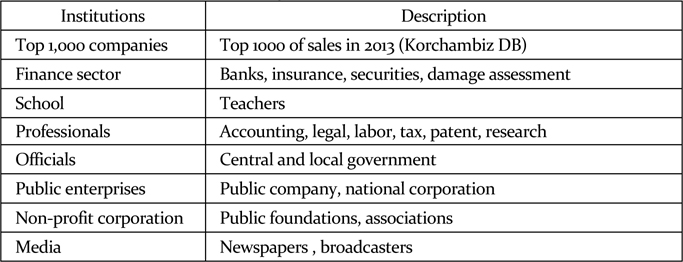
Configuration of the preferred job
Detailed variables belonging to each category are shown in Table 2. Private attributes include gender, household income and college transfer. As for gender, in 2014, the employment rate of Korean four-year college graduates is 58.5% male and 51.1% female (Korea Educational Development Institute, 2014). Gender affects employment. In prior studies, household variables are commonly the level of household income. This study uses the data of proxy variable of ‘welfare scholarship, hope scholarship and e-smile scholarship’ paid to students with low-income parents.
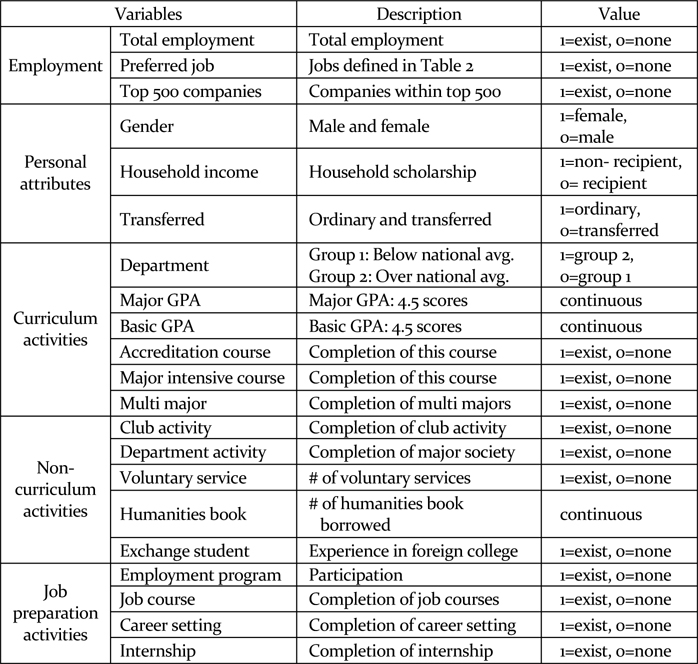
Variables
To see whether there are departmental effects, departments were divided into 2 groups with the group 1 below average of national total in employment rate and the group 2 with above average employment.
Regarding systems of education, intensive major courses since 2002, courses for Accredited Engineering Education System (hereafter engineering accreditation) since 2005 and multi major systems are included as independent variables.
Variables for non-curriculum activities include activities for various clubs, activities in each department, voluntary service activities, exchange program with foreign colleges, and humanities book lending from university library. The number of lending humanities books in library may be a variable for personality.
Variables for job preparation activities include participation in employment programs, completion of job related courses, career settings, and internships.
The engineering departments were included in the department classification of the Ministry of Education for education statistics. As a result, nine departments in College of Engineering and three departments in the College of Communication are included in the analysis.
Employment statistics are complex. The Ministry of Education considers workers registered in health insurance schemes on June 1 as employees in the 2009 employment survey of graduates on August 2009 in order to improve the reliability of employment data. However, the survey standards were changed from the August 2014 survey: standard date running from June 1 to December 31, and the integration of the national health insurance DB and national Tax DB. Therefore, this research uses the data from August 2009 to February 2014. During this period, engineering graduates at university ‘A’ totaled 4,176, with 2,234 (53.5%) from the College of Engineering and 1,942 (46.5%) from the College of Communication.
As shown in Table 3, Model 1 with private attributes shows that male students are more successful than female students in employment, students from higher household income fare better than those from lower income households, and generally enrolled students are doing better than transferred students.
[Table 3] Determinants on total employment
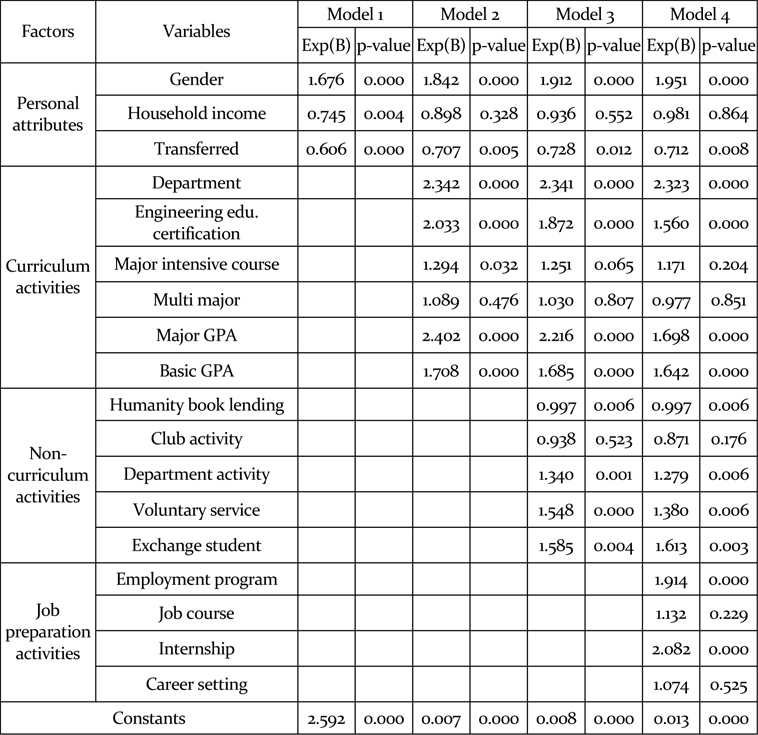
Determinants on total employment
Model 2 shows that, with curriculum activities on employment using private attributes variables, the characteristics of gender and transferred students become more obvious. However, the coefficient of household income is not statistically significant. This trend is stronger in Model 3 and Model 4, which comprise more variables. It shows that curriculum activities at the same level cannot overcome the unfavorable effect of gender and transfer.
In Model 2’s curriculum activities, group 2 with a better employment rate than the national average is positive for employment. Graduates from engineering accreditation courses and major intensive courses are well positioned for employment, but the effect on employment of engineering accreditation is better than the effect of major intensive courses. Multi-majoring has no statistical significance. As for students with high GPA in major and basic courses, they are doing well in securing employment.
Model 3 analyzes changes in the impacts of personal attributes and curriculum activities by introducing non-curriculum activities. With non-curriculum activities, the private attributes characteristics are strengthened and the effect of curriculum activities is weakened. As for the four non-curriculum activities, the decreasing order of impact on employment is as follows: exchange students, voluntary service, and departmental activities. Humanities books produce a negative impact on employment and club experience is not statistically significant.
Model 4 looks at the impact on employment of job preparation activities. Attendance at employment programs and internship experience has a positive impact on employment. However, the completion of job-seeking courses and career setting has no statistical significance.
The analysis of preferred job on employment is shown in Table 4. Overall, results are not different from those for general employment. First, personal attributes seem to be stronger if other categories are added. Men rather than women and regular entrants rather than transferred students have positive impacts on employment. In addition, as shown in general employment, no statistical significance is found as regards household income. Second, when curriculum and non-curriculum activities are added, they tend to reduce the influence of individual factors. It is almost similar for each factor in terms of statistical significance as general employment.
[Table 4] Determinants on preferred job employment
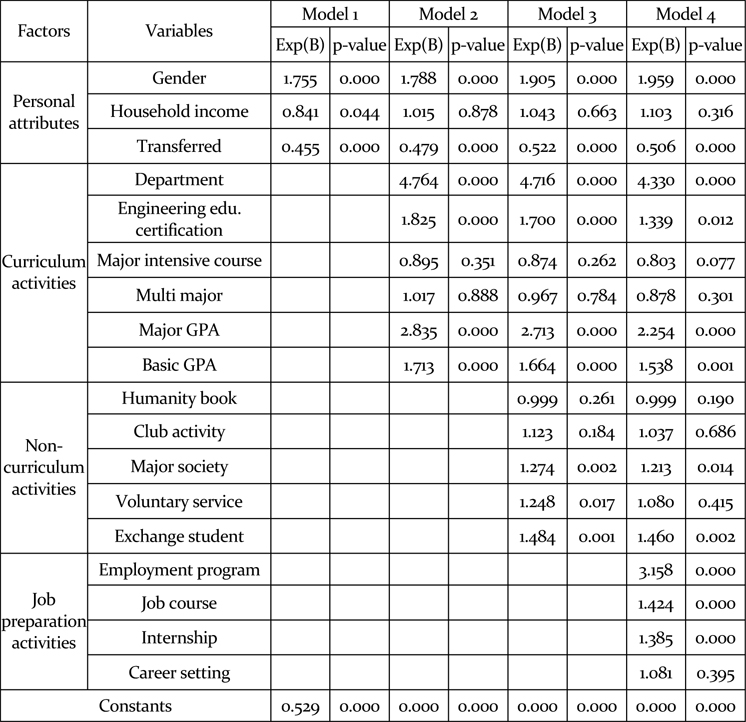
Determinants on preferred job employment
The results of the top 500 companies are shown in Table 5 and the trend is almost the same with those of general employment and employment on preferred job.
[Table 5] Determinants of employment on the top 500 companies
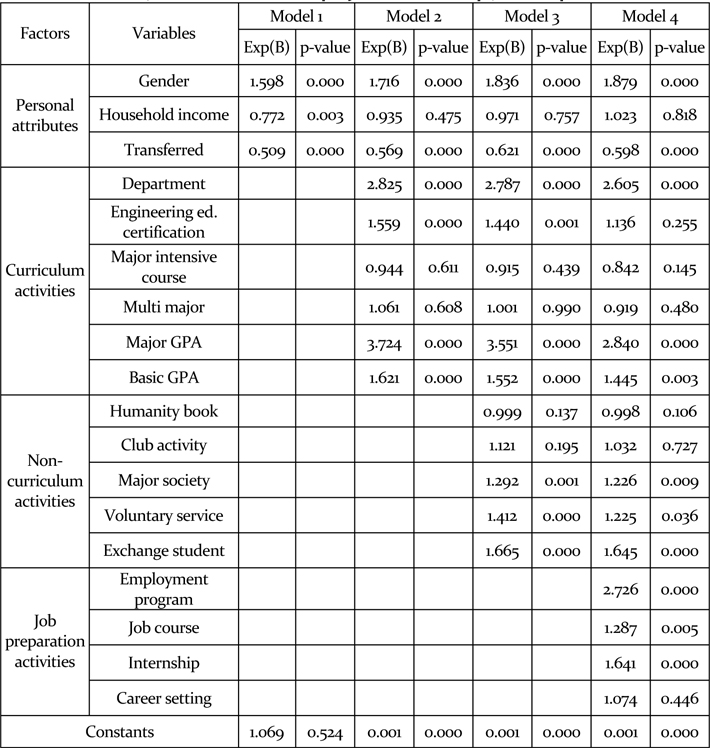
Determinants of employment on the top 500 companies
Table 6 summarizes the results of the four models. It shows the impacts of total variables on different definitions of employment.
[Table 6] Results by variables
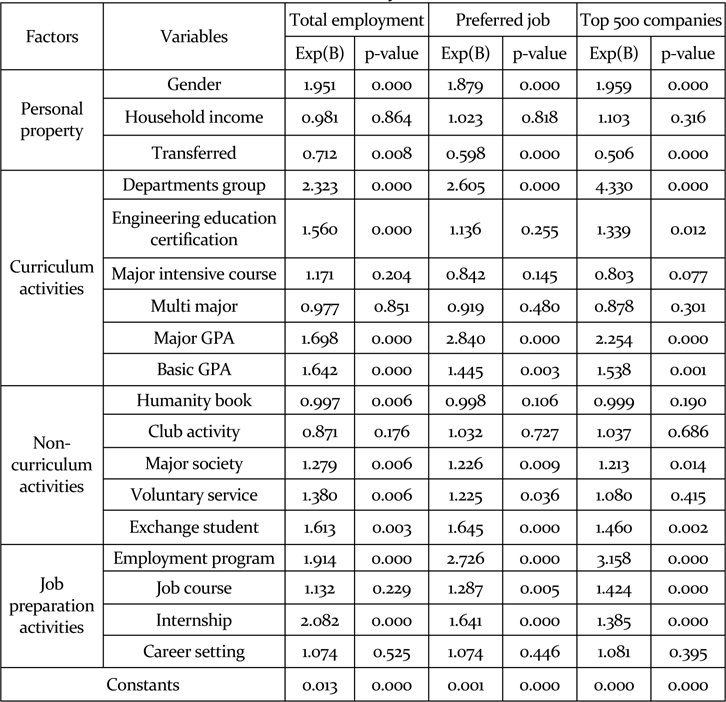
Results by variables
As for gender, men fare better than women in total employment, preferred job and top 500 companies. Transferred students do not do as well as ordinary entrants students and the trend is accentuated at large-scale enterprises. Family income is not statistically significant, which is the opposite conclusion of a previous study (Kim, 2009) that suggests that the lower the household income, the less opportunities of employment.
Departments involved in curriculum activities show a higher level of employment. As regards same major variable, those departments above the national average rate of employment are improving with a higher level of employment. In impact order, top 500 companies come first, followed by preferred job and general employment.
Graduates with engineering accreditation are doing better in overall employment with the top 500 companies compared to other students without accreditation, but there is no significant difference with the preferred job variable.
The various definitions of employment produce no statistical significance in terms of job prospect for graduates with major intensive courses and multi-majors. Every student in the engineering school of university ‘A’ must choose one course among engineering accreditation or major intensive courses. If not, the student should move into multi-major for graduation. However, our results show that major intensive courses and multi-majoring are not effective for employment. This presents a big implication for university policy.
Major GPA and basic GPA have an effect on employment. Major GPA has a greater impact on employment than basic GPA in any definition of employment. A student from a below average department will need a higher GPA to succeed than a student from an above average department.
Non-curriculum activities, club activities and career setting have no statistical significance on the impact on employment in any definition of employment. The humanities book variable has a negative effect in total employment and no statistical significance in the employment of preferred jobs and top 500 companies. In conclusion, humanities book does not produce a positive effect on the employment of engineering students.
Department activities and volunteer service variables give an edge on employment as well as on the quality of employment. However, the effect is weakening the quality of employment. Exchange students have a greater impact on employment than department activities and volunteer service.
As for the variables of employment preparation activities, employment program participation and internship experience, they show a significant positive impact on employment. The employment rate of employment program participants increases significantly with the level of employment. Participation to employment programs can be understood as a personal commitment to prepare for employment. The will to get a job may be an important determinant. The Internship experience shows a significantly positive impact on all types of employment. However, the effect is reduced with the quality of employment. The employment courses have a positive impact on preferred jobs and top 500 companies’ employment. Like the effect of employment program participation, the size of impact has increased with the quality of employment. Some 20.1% of students had career settings in mind. However, this variable shows no statistical significance. This is the same conclusion of the study by Cho and Kim (2014).
This study is based on student data from the engineering department of University ‘A’, from August 2009 to December 2014. It examines 33 types of data about private attributes, college entrant characteristics, curriculum activities, non-curriculum activities, and employment preparation activities of graduates. The variables were drawn from previous studies, but 18 variables were selected through the Cramer value from X2 Test.
The employment data of the Ministry of Education was used to improve the reliability of the results. Employment is classified into three types to reflect the quality of employment such as general or total employment, preferred jobs, and top 500 companies. Four categories were constructed such as personal attributes, curriculum activities, non-curriculum activities, and employment preparation activities, designed through hierarchical linear models. Data forms of major GPA, basic GPA and humanities books are easily available, and the other variables consisted of 0 and 1, so the binomial logistic regression model was used for the analysis.
The results for each variable are as follows:
• Women are disadvantaged in employment than men. Considering that women have higher GPA than men, the demand characteristics of companies may be more important than students’ factors. • Transferred students are disadvantaged in employment than ordinary entrants. Although it is not shown in the analysis, main reason may come from the fact that they have lower major credits. • Major GPA has a significant impact on employment as well as the quality of employment. • Graduates from the departments of lower employment rates should show better major capability than those from the department of higher employment rates in order to enhance the quality of employment. • Major intensive courses and double majors do not have significant impacts on employment. • Club activities, humanities book, or career setting do not have impacts on employment. • Departmental activities, exchange student, and volunteer service have positive impacts on employment, but the effect is reducing with the quality of employment. • Employment program participation has a positive impact on employment. The impact is increasing with the quality of employment. • Job courses have a positive impact on big company employment, but do not have a significant impact on total employment. • Internship has a positive impact on employment but the effect is reduced with the quality of employment.
This study is unique in using large-scale, historical data and internal data of a particular university. In addition, this study includes unique variables such as detailed student activities of departmental activities, club activities, voluntary service, humanities book reading, detailed curriculum provided by the university such as engineering accreditation courses, major intensive courses and multi-majoring. Therefore, this analysis can be useful to determine university policy, and is advancing the theoretical understanding surrounding employment factors.
The strongest determinants are summarized in Table 7. The top determinants including in each definition of employment are department group, gender, employment program, and internship program. Also, major GPA and basic GPA are added as a result of curriculum activities. These factors can be classified into the departmental effect, gender, and student’s will to get a job. Good departments are those that assist students in their quest for employment and, thus, achieve higher rate of employment. Students with a higher commitment to find a job, combined with a good GPA and participation to employment program or internship increase their employment prospects significantly. If a female student wants to avoid the negative effect of gender, she should make a great commitment in her will to find a job.
[Table 7] Determinants of employment for engineering
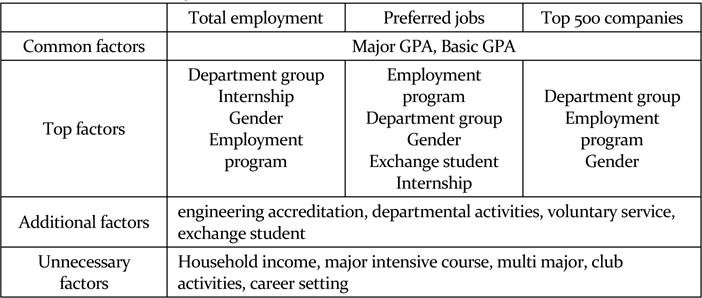
Determinants of employment for engineering
It is surprising that education programs from an engineering college such as major intensive courses and multi-majoring have no impact at all on employment rate. This will trigger serious discussions within faculty. Also, the fact that there is no impact from household income level highlights the role of university.
3. Limitations and Further Study
This study has the following limitations:
• Employment is a result of an interaction between various factors in the supply of graduates and the demands of companies. However, this study is essentially based on student factors and does not take into account the demand side. This is a clear limitation of this study, a limitation affecting previous studies as well. • Possible personal factors related to out-of-university activities such as various certifications for professional capabilities, part-time work experience, and award granting are not analyzed. • There is a limit on data so far as they are drawn from only one university.
This is an analysis of engineering departments’ employment performance, so the results cannot be transferred to other sectors, in particular humanities and social science. Hence, further studies will need to focus on these areas. If date can be compiled from additional studies, the results can form a solid basis for universities’ employment policies.






